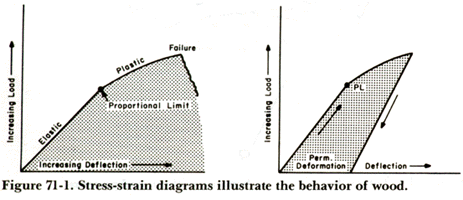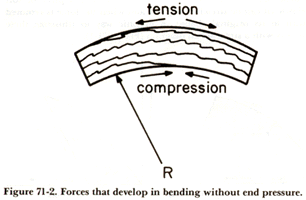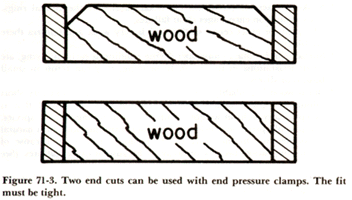by Professor Gene Wengert
Editors note: The following article is an excerpt from the book "The Wood Doctor's Rx," by Gene Wengert, retired Professor and Extension Specialist in Wood Processing, Department of Forestry, University of Wisconsin-Madison.
The bending room of a furniture plant is often a room of mystique and amazement-a place where, when the bending room foreman retires, defects and rejects show up like dandelions in the spring lawn. Yet, with a knowledge of the basics of wood bending and with suitable raw material and equipment, nearly every bend can be made successfully. Even with a severe bend, rejects should not exceed 10%. This is because of the fact that, although wood bending is an "art," it is solidly backed by engineering theory.
Behavior of Wood
The most important point in wood bending is that wood is both plastic (it can be deformed permanently, without breaking, like a piece of soft wax) and elastic (it can be stretched slightly and when the force is removed it will return to its original shape). A graphic way to illustrate these characteristics is with a stress-strain diagram (Figure 71-1).

Below the proportional limit, wood behaves elastically. Above the proportional limit, wood behave plastically. An increase in force results in a permanent deformation even when the force is removed (Figure 71-1). Of course, too much force results in failure. (There is also a time effect called "creep" that we are overlooking for now.)
How does this relate to bending? If we bend wood, we want to operate in the plastic range; if we stayed in the elastic range the bend would not be permanent. Likewise, if we exceed the plastic range, the bend would result in failure.
There is one property of wood that makes it possible for us to make severe bends. That property is that when wood is steamed (high moisture and high heat), the plastic range in compression is extended and becomes extremely large (up to ten times the dry range). On the other hand, steaming does not affect the tension properties.
I should mention at this time, however, that steaming does cause an overall loss in strength after the piece is dried, so we do want to keep the steaming time to a necessary minimum.
Anatomy of a Bend
Consider a flat piece of wood 10 in. long and 1 in. thick. As we bend this piece, the outside of the arc will be longer than the inside (Figure 71-2). A flat piece of wood when bent can normally absorb a difference between outside and inside radius of 2 to 3% (without using end pressure or steaming) before breaking. This means a 1-in.-thick piece, 20-in.-long, could be bent on a 24.7 in. radius. The rule of thumb is that the radius cannot be less than 20 to 30 times the wood's thickness without steaming and end pressure.

When we steam wood, it becomes more plastic in compression and is, therefore, able to accept more deformation without failure. However, wood does not become much more plastic in tension; the steam only increases plasticity in compression. Returning to the bend in Fugure 71-2 we must understand that the outside radius, which is in tension, is the limiting factor in any bend, even after steaming-although after steaming, the severity of the bends may, in certain cases, be increased without failure.
So the key to severe bends is to control or reduce the tension in the outer radius. The most effective method is to push on the ends, generating a compression force that will offset the tension force from the bend. How hard do we push? We know that the outer (tension) radius cannot elongate by more than 3% before failure is likely. Therefore, we push hard enough to keep the outer radius at nearly a constant length-that is, its length when it was flat.
Traditional method is the use of a clamp or bar as shown in Figure 71-3, or a variation of this idea, with the distance between the end blocks exactly the length of the piece. Let me repeat: Exactly the length! If there were play between the end blocks and the piece to be bent, it is likely that the 3% elongation limit would be exceeded and failure would result. (In fact, it has been my experience that short miscut lengths are the second most frequent cause of bending failure. The leading cause is poor material selection for bending stock. The third cause is improper moisture content.)
In practice, there are two correct ways to cut the ends of the stock so it will fit between the block: Flush and bevel (Figure 71-3, top and bottom respectively). I am not aware on any practical difference between these two acceptable methods.
One additional consideration in bending wood: it does take a moment or two for the wood to absorb the stresses being generated in bending. So the bend must be made relatively slowly.
Now that we have the basic ideas behind successful bending, let's examine bending stock selection, preparation, drying, steaming, and redrying.

Stock Selection
The U.S. Forest Service has evaluated 25 hardwood species for relative bending quality. In their testing, the best 17 woods were:
Hackberry (Best)
White Oak
Red oak
Chestnut oak
Magnolia
Pecan
Black walnut
Hickory
Beech
Elm
Willow
Birch
Ash
Sweetgum
Soft maple
Yellow-poplar
Hard maple (Worst)
This ranking represents the results from one evaluation; variation in the results can be expected from tree to tree and site to site.
A further test of 20 different white oak trees showed that the specific gravity (or density) and the rate of growth had no effect on bending failure. Likewise, the amount of end pressure (in excess of that required) was not related to the number of bending failures. (In other words, a piece that is going to fail will fail even if additional end pressure is exerted.) HOWEVER, bending quality was related to certain strength-reducing defects:
- Cross-grain wood is more likely to break than straight grain. the rule of thumb is that the grain should slope no more than 1:15 along the piece. Occasionally, there can be "local cross grain" (near a knot, for example) that can result in failure. A special form of cross grain is the interlocked grain, which is especially weak.
- Knots are accompanied by distorted grain and represent weak areas.
- Shake is a separation within the wood parallel to the annual rings. This separation encourages shear failures.
- The pith (or exact center of the tree) is very weak and failures there are likely.
- Surface checks, due to improper drying conditions early in drying, are small separations in the wood. In bending, they can result in small bumps or slivers.
- Brash wood is probably found in all species and results in very short (along the grain) breaks rather than longer slivers. Wood that is exceptionally light in weight, compared to the average for the species is especially prone to brashness. Brashness can, therefore, be a natural phenomenon. On the other hand, brashness can result because of overheating wood, because of decay, or because of earlier failure. (See Chapter 64.)
Professor Gene Wengert is Extension Specialist in Wood Processing at the Department of Forestry, University of Wisconsin-Madison. His Book, The Wood Doctor's Rx, is available from http://www.fdmbookstore.bigstep.com/.